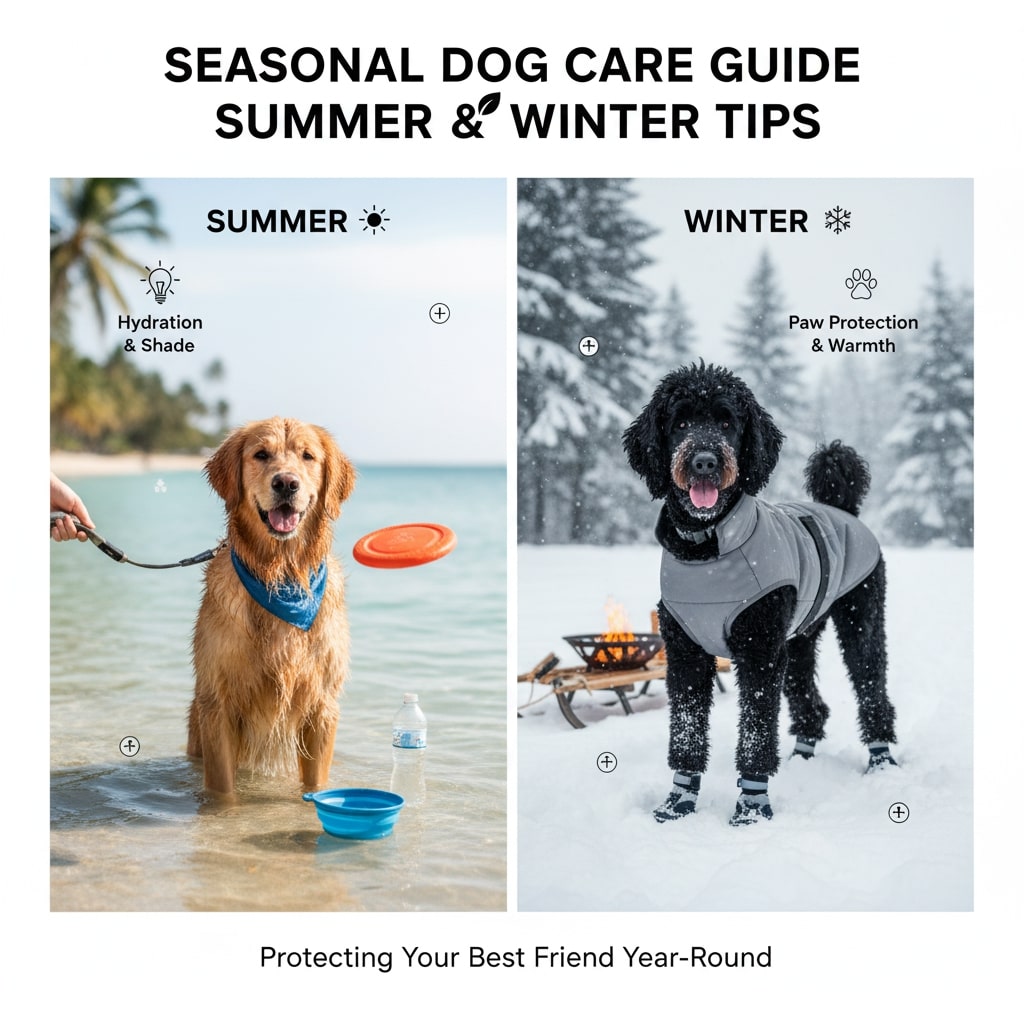Season-by-Season Care Strategies for Happy, Thriving Dogs
Keeping your dog healthy and happy throughout the year means understanding how seasonal changes affect their well-being. Dogs, like humans, are affected by weather, and it’s essential for pet owners to adapt care routines for both hot summers and cold winters. This comprehensive guide provides actionable tips and advice specifically for US dog owners to ensure their pets stay safe, healthy, and comfortable all year round.

Table of Contents
- Introduction
- Summer Dog Care Tips
- Hydration and Nutrition
- Heat Protection
- Exercise and Outdoor Activities
- Skin and Coat Care
- Signs of Heat Stress
- Winter Dog Care Tips
- Cold Protection
- Nutrition and Weight Management
- Indoor Exercise
- Paw and Skin Care
- Signs of Hypothermia
- Seasonal Health Checks
- Travel and Outdoor Safety
- Grooming for Seasonal Comfort
- Special Considerations for Different Dog Breeds
- Conclusion
Dogs are beloved companions, and their care should evolve with the seasons. In the US, summers can range from hot and humid to scorching, while winters may bring freezing temperatures, snow, and ice. Understanding the seasonal needs of your dog can prevent health issues, enhance comfort, and promote longevity.
- Temperature Sensitivity: Dogs have varying tolerances to heat and cold depending on breed, age, and health.
- Activity Levels: Seasonal changes affect exercise routines and energy expenditure.
- Health Risks: Heatstroke, dehydration, frostbite, and hypothermia are preventable with proper care.
Summer Dog Care Tips
Summer is a season for outdoor fun, but extreme heat poses risks for dogs. Implementing proper summer care can keep your dog active and healthy.
Hydration and Nutrition
- Provide Fresh Water: Ensure your dog has constant access to clean, cool water.
- Electrolyte Solutions: Consider dog-safe electrolyte solutions for prolonged outdoor activities.
- Light Meals: Offer lighter, more frequent meals to prevent overheating.
- Avoid Human Snacks: Foods like chocolate, grapes, or caffeine are toxic.
Heat Protection
- Shade and Shelter: Keep dogs in shaded areas or indoors during peak heat hours (10 am to 4 pm).
- Cooling Mats & Vests: Use cooling mats, vests, or bandanas to reduce body temperature.
- Limit Hot Pavement Walks: Hot asphalt can burn paw pads. Test surfaces with your hand before walking.
Exercise and Outdoor Activities
- Early Morning or Late Evening Walks: Avoid the hottest parts of the day.
- Water Activities: Swimming or splash play can help dogs cool off.
- Indoor Games: If it’s too hot outside, interactive toys or fetch inside can provide mental and physical stimulation.
Skin and Coat Care
- Grooming: Regular brushing removes excess hair and promotes airflow.
- Sun Protection: Apply pet-safe sunscreen on exposed areas for short-haired dogs.
- Flea & Tick Prevention: Warm months increase parasite activity; consult your vet for preventive treatments.
Signs of Heat Stress
- Excessive panting or drooling
- Rapid heartbeat
- Weakness or collapse
- Vomiting or diarrhea
- Seek immediate veterinary care if these occur
Winter Dog Care Tips
Cold weather brings unique challenges. Protecting dogs from low temperatures, snow, and ice is vital.
Cold Protection
- Warm Clothing: Short-haired or small breeds may benefit from sweaters or jackets.
- Sheltered Sleeping Areas: Ensure indoor sleeping areas are draft-free and warm.
- Limit Time Outdoors: Avoid prolonged exposure to freezing temperatures.
Nutrition and Weight Management
- Caloric Needs: Some dogs may require slightly higher calories in winter to maintain body heat.
- Healthy Fats: Incorporate healthy fats for energy and coat health.
- Monitor Weight: Overfeeding can lead to obesity, which complicates mobility.
Indoor Exercise
- Play Games: Fetch, tug-of-war, or puzzle toys keep dogs active indoors.
- Training Sessions: Mental stimulation is as important as physical exercise.
- Doggy Daycare: Consider for high-energy dogs during extreme weather.
Paw and Skin Care
- Paw Protection: Use dog booties or paw wax to prevent cracking and ice ball buildup.
- Moisturize: Use vet-approved moisturizers to prevent dry, cracked skin.
- Check for Ice Melt Chemicals: Some ice-melting products are toxic; rinse paws after walks.
Signs of Hypothermia
- Shivering or trembling
- Lethargy
- Slow heartbeat or breathing
- Pale or blue gums
- Immediate veterinary attention is required
Seasonal Health Checks
- Regular Vet Visits: Schedule check-ups at least twice a year.
- Vaccinations & Preventives: Keep flea, tick, and heartworm preventives up-to-date.
- Weight Monitoring: Seasonal changes in activity may affect weight.
- Dental Care: Dental hygiene affects overall health year-round.
Travel and Outdoor Safety
- Summer: Never leave dogs in parked cars, always carry water, and use sun protection.
- Winter: Use reflective gear during early night walks, and avoid frozen bodies of water.
- Emergency Kits: Include first aid, water, and food when traveling.
Grooming for Seasonal Comfort
- Summer: Trim long fur but avoid shaving too short; regular brushing removes dead hair.
- Winter: Maintain a full coat for insulation; brush regularly to prevent mats.
- Bathing: Use seasonal-appropriate shampoos for skin and coat health.
Special Considerations for Different Dog Breeds
- Short-Haired Breeds: More vulnerable to cold; may need jackets in winter.
- Thick-Coated Breeds: Can overheat in summer; provide shade and water.
- Small or Toy Breeds: Susceptible to both extremes; monitor closely.
- Senior Dogs: Require gentle care, adjusted activity, and warm bedding.
Conclusion
Seasonal dog care is essential to ensure that your furry friend remains healthy, happy, and safe year-round. By paying attention to hydration, nutrition, exercise, grooming, and environment, you can prevent seasonal illnesses and enjoy quality time together. Each season brings unique challenges, but with proactive measures, you can make sure your dog thrives, whether under the summer sun or the winter snow.
This guide serves as a comprehensive resource for US dog owners looking to implement seasonal care routines. For more personalized advice, always consult your veterinarian, especially when introducing new diets, exercise routines, or protective gear for your dog.
⚠️ NOTE: This post is for informational purposes only. Please see our full Disclaimer Page for details.
